
Mahjong or mah-jongg is a tile-based game that was developed in the 19th century in China and has spread throughout the world since the early 20th century. It is commonly played by four players. The game and its regional variants are widely played throughout Eastern and South Eastern Asia and have also become popular in Western countries. The game has also been adapted into a widespread online entertainment. Similar to the Western card game rummy, Mahjong is a game of skill, strategy, and luck. To distinguish it from mahjong solitaire, it is sometimes referred to as mahjong rummy.

Scrabble is a word game in which two to four players score points by placing tiles, each bearing a single letter, onto a game board divided into a 15×15 grid of squares. The tiles must form words that, in crossword fashion, read left to right in rows or downward in columns, and be included in a standard dictionary or lexicon.
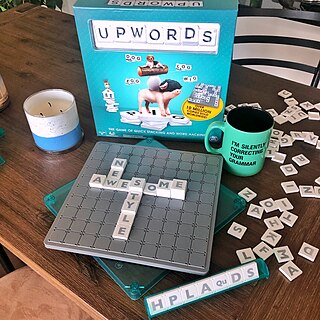
Upwords is a board game invented by Elliot Rudell and originally published by the Milton Bradley Company, now a division of Hasbro. Worldwide marketing rights to Upwords have been licensed to Spin Master Inc. by Rudell Design, LLC as of 2018. Upwords is similar to Scrabble or Words With Friends, in that players build words using letter tiles on a gridded gameboard. The point of difference is that in Upwords letters can be stacked on top of other letters already on the gameboard to create new words. The higher the stack of letters, the more points are scored. This typically makes words built in later turns of the game more valuable than earlier words, increasing play intensity and adding a level of strategy unique to Upwords. The memorization of two-letter words is considered a useful skill in this game.
Tigris and Euphrates is a tabletop eurogame designed by Reiner Knizia and first published in 1997 by Hans im Glück. Before its publication, it was highly anticipated by German gamers hearing rumors of a "gamer's game" designed by Knizia. Tigris and Euphrates won first prize in the 1998 Deutscher Spielepreis. A card game version was released in 2005.
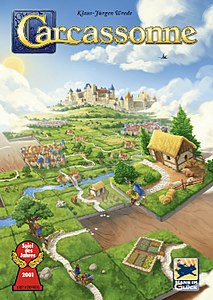
Carcassonne is a tile-based German-style board game for two to five players, designed by Klaus-Jürgen Wrede and published in 2000 by Hans im Glück in German and by Rio Grande Games and Z-Man Games (currently) in English. It received the Spiel des Jahres and the Deutscher Spiele Preis awards in 2001.

Alhambra is a 2003 tile-based German-style board game designed by Dirk Henn. It was originally published in Germany by Queen Games in a language-interdependent version; an English-specific version was released in North America by the now-defunct Überplay. The game is an Arabian-themed update, set during the construction of the Alhambra palace in 14th century Granada, of the 1998 stock trading board game Stimmt So!, which in turn was an update of the 1992 mafia influence board game Al Capone; the original version was subsequently released as Alhambra: The Card Game.
Scrabble variants are games created by changing the normal Scrabble rules or equipment.
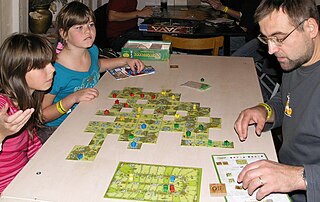
Carcassonne: Hunters and Gatherers is a German-style board game. It is a member of the Carcassonne family of board games, and was developed by Klaus-Jürgen Wrede. It was first published in 2002, in German by Hans im Glück, and in English by Rio Grande Games. In 2015, the English Second Edition was published by Z-Man Games.
Carcassonne: The City is a German board game for two to four players. As a member of the Carcassonne family of games, it is created by Klaus-Jürgen Wrede and distributed by Hans im Glück in German and Rio Grande Games in English. Like other Carcassonne games, the objective of the game is to score points based on placement of the tiles. However, The City also adds city walls and towers, which can inhibit the growth of the playing field in a certain direction. The City is packaged in a "deluxe" manner: the box itself is made from wood, as are the parts for the city walls, followers, and towers.

Puzzle Pirates is a massively multiplayer online game developed by Three Rings Design. The player takes the role of a pirate, adventuring on the high seas and pillaging money from roaming enemy ships. The mechanics of Puzzle Pirates are driven by puzzles. For example, to effectively sail a ship, players must play puzzle games representing work at the sails for speed, pumping bilge water to remove it from the ship, and carpentry to fix any damage the ship may take.

Muggins, sometimes also called All Fives, is a domino game played with any of the commonly available sets. Although suitable for up to four players, Muggins is described by John McLeod as "a good, quick two player game".
Carcassonne: The Castle is a two-player German board game. It is designed by Reiner Knizia, although Carcassonne series creator Klaus-Jürgen Wrede is also credited. Like other games in the Carcassonne series, it is published by Hans im Gluck in German and Rio Grande Games in English.
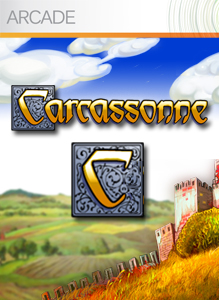
Carcassonne is a turn-based strategy video game, based upon the board game of the same name designed by Klaus-Jürgen Wrede for the Xbox 360, published by Vivendi Games under their Sierra Online subsidiary, and developed by Sierra Online Seattle, formally known as Secret Lair Studios. The Xbox 360 game was released on June 27, 2007, and is the second designer board game to be released on Xbox Live Arcade, the first being Catan.
Realm of the Desert Sons is a German-style board game published in 2008 by Klaus Teuber, published by Kosmos in Germany. It is the second game in the Entdecker trilogy of games, a series of games featuring the mechanics of Teuber's previous game, Entdecker, adapted to new themes. Unlike the previous game, Realm of the Jade Goddess, Desert Sons was available for a wide release, though there are no plans to publish the game outside of the original German language. However, a computer implementation has been available on the Catan GmbH website, with a full English language translation.
Carcassonne: Wheel of Fortune 2009 is a tile-based German-style board game developed by Klaus-Jürgen Wrede and distributed by Hans im Glück in German and Rio Grande Games in English. It is considered a game in the Carcassonne series, and is considered both as a standalone game as well as an expansion set to Carcassonne.
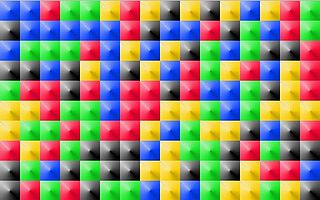
A tile-matching video game is a type of puzzle video game where the player manipulates tiles in order to make them disappear according to a matching criterion. In many tile-matching games, that criterion is to place a given number of tiles of the same type so that they adjoin each other. That number is often three, and these games are called match-three games.
WWE SuperCard is a 2014 video game for iOS and Android, and a mobile installment in the WWE video game series, developed by Cat Daddy Games and published by 2K Games. It is a collectible card game featuring WWE superstars.
My First Carcassonne is a tile-laying German-style board game developed by Marco Teubner. It is a game in the Carcassonne series, published by Hans im Glück in Germany and Z-Man Games in North America. My First Carcassonne is the third Carcassonne spin-off, following Carcassonne: The Castle and Carcassonne: The Discovery.
Keyflower is a Euro-style board game designed by Sebastian Bleasdale and Richard Breese, and originally published by R&D games in 2012. It can be played by 2-6 players. In this game, players use their workers to try to build the best village among the players, by earning the most victory points in 4 rounds. The game features strategic use of workers, where players use them both for bidding for new village tiles and to use them. It has received numerous honors, and is ranked as the 50th best game in BoardGameGeek as of 2019.

Isle of Skye: From Chieftain to King is a tile-laying board game designed by Alexander Pfister and Andreas Pelikan that was published in 2015. It uses the Isle of Skye as its setting, with players representing clan chieftans each vying to build a kingdom.










